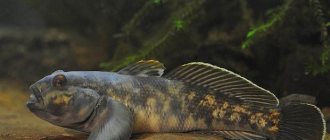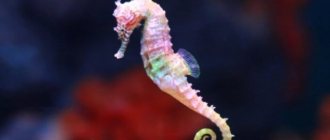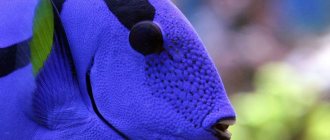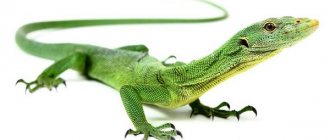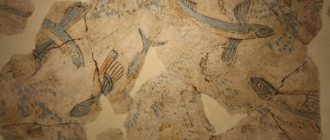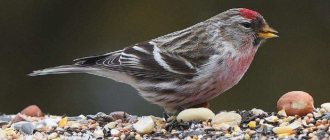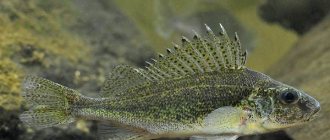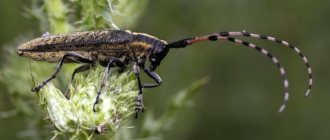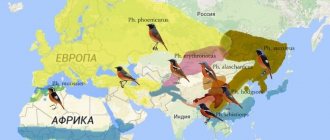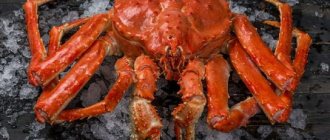crucian carp
The most popular freshwater fish of the carp family. Maximum weight 1.5 – 2 kg. It is found everywhere - in the European part of Russia, in the Urals, in Siberia. It is thanks to such a vast habitat, as well as increased fertility and excellent survival, that it is not yet afraid of extinction.
In addition, it is omnivorous, feeding on everything it can find in water and mud. It loves warmth, with the onset of cold weather it loses its appetite, buries itself in the soft thick mud and sleeps until spring. But if the reservoir has a sandy bottom, the crucian carp is forced to look for food in winter, although it no longer bites as actively.
Almost all novice fishermen learn the skill of float fishing from crucian carp; it loves everything that is at hand: bread, wheat, cereals, worms, bloodworms, maggots. He takes the nozzle confidently, the float immediately sinks or leads to the side. Even the most inexperienced fisherman can hook it.
In Rus', for a long time, not a single feast would be complete without crucian carp fried in sour cream. Crucian fish soup is less tasty because when boiled it retains a faint smell of mud. Disadvantage: crucian carp is bony, so you need to carefully sort the meat, especially for children.
Units
Belonging to a squad is one of the classification characteristics. Squads are included in classes. The latter may include several units. There are also categories such as subfamilies, superorders, etc.
Sturgeon
This is an order of ray-finned fish, part of the subclass of cartilaginous ganoids. This includes sturgeon and paddlefish. They are detected only in the Northern Hemisphere and are concentrated in numerous forms on the territory of Russia. These are Russian and Sakhalin sturgeon, thorns, stellate sturgeon, sterlet, etc.
Herring
These are primitive bony representatives from the order ray-finned. Typical pelagic fish of Russia, which can be freshwater or marine. The list includes European alose, puzankas, herring, sprat, sprat, etc.
Salmonidae
These are also ray-finned fish, which are combined into a single salmon family. The fish here are varied in size (medium and large sizes are found). Here we meet lenok, pink salmon, chum salmon, chinook salmon, sockeye salmon, coho salmon, salmon, etc. They all have reddish fatty meat.
Salmon family
This includes three subfamilies (salmon, whitefish and grayling) with varieties of fish in each of these categories. Grayling is the least numerous. There is a single genus of Grayling with three representatives.
Subfamily Salmonidae
This subfamily includes a list of 8 genera: lenka, taimen, Pacific salmon, Sakhalin taimen, Far Eastern trout, salmon, char, longfin palia. They all have specific, similar characteristics. In the northern hemisphere, they live only in fresh water. Large spawning grounds in the natural environment are located in Kamchatka, Sakhalin, and the Kuril Islands.
Subfamily Whitefish
Otherwise, these are Belorybitsy or Nelma. There are fewer incoming births here. There are only three of them: whitefish, whitefish, and whitefish. They prefer fresh water, which is why they love Russian rivers: Pechora, Northern Dvina, Ob. They also live in some lakes.
Smelt-like
They belong to the order of ray-finned fish. These are bony representatives that spawn in freshwater environments. Growing up, they move to live in the seas and oceans in the temperate climate zone. The most famous edible representatives are smelt and capelin. These are all small fish with a thin body.
Smelts
In the Northern Hemisphere (including Russia) they are found in seas and freshwater environments. These are important representatives for the fishery. In appearance, they are easily distinguished by their elongated body and not very large size, as well as their silver color.
Pike-like
Ray-finned fish, which includes 2 families and 12 species of fish. They are related to salmonids (they are part of the same order). They are found in northern Eurasian fresh water, which ensures catching in Russia.
Pike
This family includes 3 genera with 9 species. The body of such fish is elongated, with a large mouth on an elongated stigma. The most famous representatives are pikes. This also includes the lineage of Novumbra and Dahlia. They are found everywhere in Russia in fresh water bodies.
Umber
There are 7 species classified into three genera. In Russia they are found in the Danube and numerous Siberian rivers. Closer to Chukotka the number increases. They are considered hardy. These are medium-sized fish, but with a short stigma, unlike the previous ones.
Eels
Ray-finned fish, including representatives with a serpentine body shape. Their specificity lies in the method of movement - crawling and swimming with bending of the body occurs like a snake. The amplitude running through the carcass during movement is constant. With the standard form, this amplitude increases in other fish.
Family River eels
This includes 19 species and all of them are suitable for consumption. The length can be even 2 meters. In Russia they are found in the Baltic Sea basin, in rivers and lakes from the basins of the Azov, Black, White, Barents and Caspian seas. They are also found in other reservoirs of the European part of Russia.
Carp-like
This order includes a large mass of all freshwater representatives of the ray-finned class. They make up 15% of all bony fish. Their length varies from one centimeter to three meters. They are of great importance for fishing.
Carp
Found in large numbers in the temperate zone of the Northern Hemisphere. Very hardy and prolific. For fishing, roach, bream, carp, crucian carp, tench, ide, etc. are of greatest importance here. Living and dead food of plant or animal origin is acceptable for them to eat.
Chukuchanovs
The description visually resembles cyprinids. The encyclopedia lists approximately 8 dozen species in this family. In Russia there are common Chukuchan and North American ones: buffalo smallmouth, largemouth and black. Most of them are found in Kolyma.
Balitoriaceae
All members of the family are bottom-dwelling freshwater fish. The mustachioed loach, which is part of this family, is widespread in Russia. It can be found in reservoirs of Siberia and the Far East, as well as in the Pskov region.
Loaches
They live in numerous bodies of fresh water in Eurasia. There are 177 different species, grouped into 26 genera and a couple of subfamilies. These are small fish with an elongated body and unremarkable coloring. They prefer muddy bodies of water to live in. Their appearance slightly repels them, because... there is a resemblance to a reptile. The common loach, common in Russia, also has one. There is no mass fishing here, although the meat of such fish is tasty.
Order Catfish
It includes about 4 dozen families, 500 genera and approximately 4000 species. There are 10 species in fresh Russian waters. They vary in length. This parameter starts from 1.2 cm and reaches several meters and several hundred kilograms. But most of them are still represented by small fish up to 10 cm.
Catfish
Large representatives living in Russia (mainly the common catfish), which reach a length of several meters. The record is 5 meters. They are found in the bottom areas of water bodies. There are approximately 100 species, grouped into 12 genera. These fish of Russia are all bottom-dwelling and widely distributed in the Eurasian part.
Orcas
They are distinguished by a long fin on their back. The body is the same as in the previous case, elongated without scales and covered with mucus (sometimes poisonous). The border of the range in the North includes the Amur River basin. They have a medium body size and bare skin. As a standard, like all catfishes, they have antennae.
Ictaluraceae
Not very common in Russia. American catfish is found in the western regions. Reproduction in reservoirs with warm waste water from state district power plants and thermal power plants is possible after importation or their accidental entry here. It is also bred artificially in farms near Moscow.
Garfish
This order includes only one family living in Russia - Adrianichthyaceae. The rest are distributed throughout the world and differ from our species. They have an elongated body and jaws. Most of the representatives are marine species. They live in coastal areas and in open ocean waters. They are located in the surface layers. Only a third of species live in brackish and fresh water bodies. They are of great importance for fishing.
Adrianichthyaceae
In turn, this family includes only the genus Orisia. The only representative of the genus called “medaka” is found in the Krasnodar region due to the suitable climate. In appearance it is very different from other representatives of the order. It has an absolutely standard and unremarkable body shape, as well as silver-colored scales.
Cyprinodontiformes
This includes more than 1,200 species of fish. All of them are small in size and live in fresh water. Many of them are brightly colored. Based on these criteria, they are often chosen for breeding in aquariums. They resemble cyprinids in appearance, but are smaller in size. They also differ in the description of the structure of the jaw. Here the presence of teeth is revealed.
Poeciliaceae
There are approximately three hundred small viviparous species of fish in this family. They mainly live in fresh water and only a few are found in brackish and sea water. They choose different bodies of water based on size: from large to small lakes and quiet streams. But there are also turbulent passing channels.
Codfish
Member of the ray-finned order. In size, specimens range from a couple of centimeters to two meters. The location of the ventral fins on the body is similar to perciformes. And in terms of the general structure of all fins, they are cypriniform. These are mainly marine species, but there are also freshwater species. In total, there are 13 families, 84 genera and 613 species of fish.
Burbot
Burbots are distinguished by their love of fresh water. The rest of the order prefer salt water. They have an elongated body and a wide head. They are found in the Baltic, White, Barents, Black and Caspian seas, in Siberian rivers, Baikal, Yenisei, etc.
cod
“Central” representatives of the detachment in question. There are 4 subfamilies, 20 genera and 56 species. They are found in fresh and salt water in the northern hemisphere. But besides the Burbot, all other representatives live in the sea. Therefore, they cannot be found in closed reservoirs and they are rarely found in migratory rivers. The most famous genera are cod, pollock, blue whiting, navaga, and haddock.
Sticklebacks
They are included in the superorder spinyfin. Depending on the species, there are representatives of different lengths: from several to two tens of centimeters. The encyclopedia lists 11 families included in different superfamilies and suborders. There is still controversy regarding the classification of all representatives.
Sticklebacks
They belong to the suborder Sticklebacks. There are 18 species that love fresh, brackish and salt water. A distinctive feature is the presence of a spine in front of the dorsal fin. They are not valuable for fishing and it is difficult for other fish to get along with them in the same body of water, since they are excessively voracious.
Order Acicularis
Includes several families. The more famous is the needle family. They are distinguished by their elongated and “thin” body shape, which explains the meaning of the name. They also look like a tube with a mouth at the end. In Russia, only needles are found.
Needle
Or otherwise needle fish. The family includes more than 180 species and 11 of them are found in Russian waters. There are many of them in the Black Sea. Moreover, in Russia, fish are found even in the water column, although they mainly prefer shallow water and shelter in the form of algae. Males have a pouch on their abdomen for rearing young.
Order Perciformes
They are not picky and can live in the marine environment and in most freshwater bodies throughout the planet and in all climatic zones. They are valuable as commercial fish. They are distinguished by a great variety of representatives with different body sizes and colors.
Percoidei
This is a family of ray-finned representatives that live in fresh and brackish waters. The common genus of perches included here are then pike perches and ruffs. All of them are distributed throughout Northern Europe. Chops and sculpin perches, as well as percarines, are found exclusively in the Black and Azov Sea basin. Teeth and sometimes fangs grow on the jaw. There are transverse stripes along the body.
Percikhtidae
There are 34 species, grouped into 11 genera. Can reach 1.8 meters. Some species included here are under threat of extinction. In Russia they are distributed in the Amur River basin, in Lake Khanka and in the north-west of Sakhalin. Externally they have a standard appearance of perches, but are distinguished by a wide variety of colors.
Centrarchae
Otherwise called eared perches. There are up to 45 species, united in 9 genera. Distributed mainly in fresh water in North America. In Russia they are found in the Black Sea basin. Due to their bright colors and iridescent scales, they are characterized as sunfish.
Perch
In the Black and Azov Seas, chops, sculpins and perkarins are common. They have a standard appearance and size for perciformes. They are a kind of standard for all representatives of the squad. Here the structure and color that are standard for perches (including stripes on the body) are revealed. The family is represented by 236 species, grouped into 9 genera and 5 subfamilies.
Cichlids
Or cichlids. About 1,300 species fit this classification. Many are important commercial fish. Some are regarded as valuable for breeding in aquariums: sklaria, discus, oscar. Mozambian tilapia and eight-banded cichlid are found in Krasnodar reservoirs. The first spread, entering the natural environment from fish farms, and the second from aquariums.
Order Gobiiformes
These are gobiformes. Includes more than 300 genera and more than 2000 species. Representatives of the order live in freshwater and seawater. Dimensions vary from approximately 8 mm to 50 cm. They inhabit the seas with warm water that wash Russia: Black, Azov, Caspian. The most famous representative is the goby, which is actively caught and supplied as food to the population. They are prolific, so their numbers replenish quickly.
Goloveshkovye
They are also called odontobutaceae. The family includes 6 genera and 21 species. The species M.cinctus is common in Russia. It can be found in the Amur, Ussuri, Zeya river basins, as well as in Lake Khanka. During their life they migrate between freshwater and sea waters. Another species - Goloveshka - is also found in small lakes, swamps, and creeks of the Amur. They live their entire lives in fresh water.
Gobies
There are about 1300 species here. They are united into approximately 190 genera. They are divided into two groups: brackish water and marine. The first are relics that have lived in the Black Sea basin since the emergence of a communication channel with the Caspian Sea. They are also found in the Dniester and Dnieper. The second are immigrants from the Mediterranean to the Black Sea.
Order Anabantiformes
Slide-shaped. There are about 250 species, all of which are freshwater. They have an additional respiratory organ. Not relict for Russian waters. Rarely seen. Available in Primorsky Krai.
Snakeheads
In Russia you can find the snakehead, a freshwater predatory fish that sometimes reaches impressive sizes (up to a meter and 10 kg). It is caught in the Amur, Ussuri, Razdolnaya rivers and in lakes Khasan and Khanka. They have a large head, like a snake, which explains the presence of such a name. From the photo you can see their terrifying appearance, but a person’s excessive fear of such fish is not justified.
Scorpiformes
There are 7 suborders included here, 26 families, 280 genera and approximately 1,500 species. Found in seawater and freshwater. One of the representatives of the order (Pseudoliparis amblystomopsis) is considered the deepest-sea fish in nature, because. representatives are found at depths of up to 7.7 kilometers.
Kerchakovs
Otherwise called slingshots. There are about 200 species and 60 genera. They are distinguished by their large and flattened head compared to the body. Most of the species of the family are marine, living close to the shore, on the bottom. They are found mainly in the Gulf of Finland.
Golomyankovye
Perhaps the most interesting fish of Lake Baikal (as you can see from the photo) are representatives of the family such as the Golomyanka genus. Endemic to this body of water. They are pelagic representatives, always living in the water column. 35% composed of fat. They are viviparous.
Carp
Unpretentious, lives everywhere except the very North of Russia. Among “vegetarians” it is considered the largest. It can gain weight up to 35 - 40 kg, so it enjoys well-deserved authority among sports fishermen. Domestic and international carp fishing competitions are regularly held in various places.
Loves stagnant bodies of water and rivers with weak currents. It is rapidly gaining commercial weight, therefore it is in demand in fish farms. Despite the conditional herbivory, it can swallow a worm, an insect larva, a gaping fry - anything that it encounters along the way. In winter, it does not bite, descends into wintering pits and sits there until spring.
Float rods, donks, and devices for fishing with wire are suitable for it. The main piece of gear is a hook. It should be quite massive, sharp and forged, because the carp has a large mouth with thick lips, which are difficult to pierce when hooked.
This is a strong opponent, and when fishing, it often not only tears the line, but also unbends the hook. For bait, both dough and pasta, and maggot with a worm are suitable, and special boilies with specific odors are also sold.
The meat is delicious fried, baked, or stuffed. There is even a dish called “Christmas carp”. Disadvantage: bones are located not only in the skeleton, but also in meat, and with insufficient heat treatment and inattention can lead to injury to the larynx.
Sea Dragon
These close relatives of seahorses have unusual, amazing appendages on their bodies that are not fins. In fact, the function of these processes is considered to be camouflage. It looks like a broken piece of algae that is carried by the current. The sea dragon needs camouflage both when hunting small animals that serve as food for it, and to protect itself from its own enemies.
In addition to obvious help, the shoots interfere with the fish in some ways. For example, she cannot swim quickly because the “twigs” create resistance.
The color of a sea dragon can be different, it depends on what it eats, as well as on the region where it lives and on its age.
At the moment, this species is considered almost extinct. The reason for this was its very beautiful appearance: collectors and professional aquarists are willing to pay a huge amount to add such an amazing specimen to their collection. Despite the fact that their capture and transportation is prohibited without a special license, the smuggling trade of sea dragons flourishes throughout the world. The only hope for the restoration of the species is that specialized aquariums and ichthyofauna institutes have recently learned how to reproduce these rare fish.
The expanses of water have not yet been fully explored, so it is possible that many more unusual and amazing creatures will soon be discovered in the depths, causing bewilderment or admiration.
Carp
The genus of freshwater fish continues with the carp. It is sometimes called "wild carp" due to its similar appearance. But only he has an elongated body and a mother-of-pearl and gold color. In addition, carp is stronger, and the meat is denser and tougher. There are sedentary and semi-anadromous species. The former do not leave their native reservoir, while the latter tend to spawn in rivers.
An adult specimen can reach 30 kg, but the most often recorded weight is 2-3 kg. He is thermophilic, so he does not live in the north of Russia. In terms of taste preferences, it is also omnivorous, but unlike the ever-chewing carp, it feeds in accordance with the season.
In the spring it eats up vegetation, in the summer months it eats everything, and in the fall it gains weight due to protein foods: worms, larvae, crustaceans. In winter it goes deeper and falls asleep. Therefore, when choosing a bait for fishing, you need to take into account the time of year.
The gear must be especially strong - the carp is extremely strong, and it will instantly break off the thin fishing line. For fishing, feeders, donks, and, less commonly, float rods are suitable. The meat is even tastier than carp, but there are also a lot of small bones.
Long-horned sabertooth
Among the amazing inhabitants of the deep sea, one cannot fail to mention the long-horned saber-tooth, which looks very terrifying. His appearance does not deceive him: he is a fierce predator who can easily defeat an opponent one and a half times his size.
Among marine inhabitants, this species has the longest teeth relative to the rest of the body proportions. The huge lower fangs grow for a very long time and begin to interfere with the closing of the sabertooth's mouth. In order to still close his mouth, special pockets are formed in his brain, where the ends of the teeth sink while the jaws close.
These fish live at very great depths, reaching up to 5 thousand m, but can live after rising to the surface for another 7-10 days. This is extremely amazing, since the conditions of the vast depths and the surface of the ocean differ in the same way as the surface of the Earth and space.
Roach
a photo of freshwater fish near the shore has seen a school of nimble little fish lined up against the current of the river, lazily moving their tails and fins. This is a roach, the most numerous of the carp family, and very common in our rivers.
Its small elongated body is covered with silvery scales, its back is black, its head is small with orange eyes. The size is small, usually from 100 to 300 g. It feeds mainly on small worms and larvae, catches insects from the water surface, and eats plants in the water.
Active all year round, therefore it is especially loved by winter fishermen, because many other species hibernate. In the summer it is caught using a float rod with a thin line and a swallow hook; bread or dough with aromatic additives and pearl barley are used for bait.
In winter, use a regular winter fishing rod with a small jig and a sensitive nod. For bait, bloodworms or small maggots are preferable. Roach meat is not as fatty as crucian carp and is considered a bit dry.
However, the fish is very suitable for frying, drying and cooking in fish soup. Disadvantage : roach is often infected with helminths, so it must be thoroughly cleaned and subjected to long-term heat treatment.
Digestive system and nutrition
Food is lifted and held by the teeth, which are not dispersed in the mouth, from the oral cavity through the pharynx, and after the esophagus, the food enters the stomach, where it is processed by enzymes contained in the gastric juice. Food produced in the stomach passes through the liver and pancreas to the small intestine after the stomach, where unprocessed food remains are taken up through the anus or cloaca in some species.
Fish have a wide range of food items and feeding methods. In general, all fish can be divided into herbivores, carnivores, detritivores and omnivores. Herbivorous fish can feed on macro- and microalgae, as well as plants that thrive in the water. Some of these fish are adapted to feed on plankton by filtering it through specialized gill filaments on the gill arches: for example, various species of thickeners (Hypophthalmichthys, Hypophthalmichthysnobilis) feed exclusively on this resource and are strictly defined as filter-feeding fish microalgae living in the water column. Marine fish in the family Pomacentridae feed on benthic macroalgae, and each fish has its own area where it digs up all the algae and grows only the species it eats - not digging it up when feeding, but only partially feeding on it.
Predatory fish use a wide range of items as a food source. Plankton filter feeders (such as the whale shark) filter zooplankton from the water column; The fish may also feed on crustaceans, molluscs, flatworms, roundworms, ringworms and other fish. The most specialized predatory fish are those that feed on ectoparasites of other fish (Labridae, Chaetodontidae, etc.), which select parasites and dead skin fragments from the surface of the fish’s body to “customers” who specifically look for the habitat of “cleaners”.
Many species of fish can change their diet during their lives: plankton, which feed when young, or large invertebrates as adults.
Rudd
Outwardly it looks like the roach’s sister, only the body is more round. It got its name because of the color of its fins and eyes. Weighs on average 200-300 g. Loves clean, quiet water. The main menu consists of algae, but larvae and worms are excellent additions.
For fishing, the most convenient way is an ordinary fishing rod with a sensitive float, thin fishing line and a small hook. For bait it prefers bread, dough, pearl barley, and steamed wheat. The best food to eat is dried fish.
Tench
Anyone who has caught a tench at least once will never forget the impression of fighting this relatively small, but very strong fish. It lives in stagnant warm reservoirs of the European part of our country. He likes the abundance of vegetation and a thick muddy bottom in which he can dig - this is the basis of his food. Externally beautiful.
The powerful “golden” body with a wide tail is strewn with scales that look like beads. The head with a wide mouth and thick lips is adapted for digging in bottom silt. It grows on average to 30-40 cm, usually weighs 500-800 g. Although trophies of 1.2-1.5 kg are found, this is extremely rare.
They are caught using a float rod with strong, reliable tackle. The best activity is in late May - early June, when the water warms up enough. At this time he has a glutton, and he leans on the “meat kitchen”: worms, maggots, caddis flies. In the heat, he becomes full and lazy, so fishing requires constant feeding.
Its bite is peculiar: the float sways slightly, sinks slightly, as if it is “sucking in” the bait. And if you decide on the hook incorrectly, you can simply pull the bait out of his mouth. In addition, even when the prey is on the shore, it is too early to celebrate victory. The tench is so slippery that it is impossible to hold it in your hands.
Experienced fishermen throw it away from the water's edge. Then they remove the slippery prey from the hook, holding it by the gills. Tench is tasty and is most often fried or baked. There are few bones, but it is difficult to clean.
Therefore, it is better to cook small fish, up to 200-300 g, with their scales. It is so fine that you won't even notice it when you eat it. As it grows, the taste decreases - the meat becomes a little bitter, and the skin becomes tough.
Bream
Another member of the carp family, however, bears little resemblance to its relatives. In common parlance there is such an expression - “give bream”, i.e. hit with your palm. The fact is that in appearance it resembles a palm - flat, but rounded. The older, the rounder. The head is small, the body is covered with dense scales.
The color is silver-moon, with a golden hue appearing as it matures. On average it weighs 2-3 kg. Many are sure that bream and bream are different fish, but the first is just an outgrown second. According to fishermen, the border between them is at 1 kg.
If below are breams, above are breams. It lives in calm lakes and deep rivers of the European part of the country. Considered an omnivore, it eats algae, worms, larvae, crustaceans - whatever it finds. It spawns at the very end of May, after which it begins to feed heavily.
Bream are caught using float rods and various bottom gear. The fishing area must be fed with steamed wheat and cake in the evening, and fishing should be done in the early morning. The bait is quite varied. Bream prefers dough, pasta, wheat, and corn.
A serious trophy is caught with a “brush”, when several earthworms are attached to a hook at once. Bream is interesting as an object for sport fishing, but as a food product it is a little disappointing. Disadvantage : abundance of small bones. Because of this, the price is highest in dried form.
White amur
This fish originally comes from the Far East, from the Amur River, hence the name. Then they began to import it to other places, and so it gradually spread almost everywhere in Russia. Grass carp is strong and large and can gain weight up to 30 kg. Loves slow flowing or standing water. The scales are white, which is also reflected in the name.
Due to its rapid weight gain, it is of great commercial importance. He only eats grass. If you run it into an overgrown pond, then after a short time the pond will be significantly cleared of algae. Zhor falls at the end of May - June, when spawning ends.
They catch it exclusively with vegetable baits: corn, grain, porridge; float rods or donks are suitable. Spinning fishing has proven itself well. The fishing line is equipped with a tee without a sinker, on which a cabbage leaf is wound and released with the flow.
Cupid grabs the juicy bait from the surface and ends up on the hook. Fighting with large fish is even more exciting, because... you have to pull against the current. It is usually fried or baked, since carp meat is tender and moderately fatty.
Structure
The internal structure of fish is presented in the table.
| Organ system | Organs | general characteristics |
| Musculoskeletal | Skeleton, muscles | The skull includes the braincase, paired gill covers and arches, and jaws. The paired fins are mobile. The spine consists of vertebrae with processes - two look down and form ribs, one is raised up. Muscles are divided into segments |
| Digestive | Digestive tract, glands | The tract consists of the mouth, pharynx, esophagus, stomach, and intestines. Ends with the anus. The ducts of the pancreas and liver open into the intestines. Some fish have teeth |
| excretory | Ribbon-shaped paired kidneys, ureters, bladder | The blood is filtered by the kidneys. Urine is formed and flows through the ureters into the bladder. From there it is excreted through the urethra |
| Respiratory | Gills | Located in the pharynx. Gill filaments, which are penetrated by capillaries, are attached to the gill arches. Gas exchange occurs through them |
| Blood | Two-chambered heart, arteries, veins, capillaries | The heart consists of a ventricle and an atrium, through which venous blood passes. One circle of blood circulation starting from the ventricle. Venous blood flows through the gills, becoming saturated with oxygen. After delivering oxygen to all organs and tissues, the blood returns to the atrium |
| Nervous | The brain includes the forebrain, diencephalon, medulla oblongata, midbrain and cerebellum, spinal cord along the spine, nerves | The midbrain, diencephalon and cerebellum are well developed. The sense organs are represented by the eyes, nostrils, inner ear, and lateral line, which detects vibrations. Taste buds are found in the mouth and on the skin |
| Sexual | Ovaries and oviducts in females and testes and vas deferens in males | Fertilization is most often external |
Rice. 2. Internal structure.
The scales of fish are constantly growing, and annual rings are formed on them.
Silver carp
It is quite unpretentious and tasty, so it is in demand for breeding in commercial ponds. It is much less common in nature. Outwardly, it bears little resemblance to its relatives from the carp family. A fairly long freshwater fish with a flat back and rounded belly. It is also distinguished from cyprinids by its small scales with a bronze tint.
A powerful head with a prominent mouth completes the look. Most often, the weight ranges from 1.5 to 3 kg, but some individuals reach 15-16 kg. It feeds on phytoplankton and algae, so it also perfectly cleans water bodies.
It likes to graze in schools closer to the surface of the water, and is caught using a float rod with well-chosen tackle. To eat, silver carp is fried, baked or stewed. Disadvantage : clearing it of scales is not an easy task.
We looked at several types of “peaceful” fish, loved by fishermen and welcome “guests” on our tables. Predators of underwater fauna are no less valuable as trophies and are also tasty. They are distinguished by the fact that they hunt their own kind, sometimes even eating their close relatives with pleasure. Let's start the story with the brightest representative - the pike.
Pike
A predatory freshwater fish, the river “lone wolf,” lives everywhere in our country. It hides in the grass and waits patiently for a gaping or sick, weak fish to swim past. Then she flies out of the ambush like an arrow and grabs the prey. If the cast is unsuccessful, the pike rarely pursues the fish.
More often she returns to her original place and again freezes in anticipation. If you catch it, then after a while the place convenient for hunting will be occupied by another predator. The pike has a long body, the color of its scales depends on its habitat. The head is large with a huge mouth, in which there are many razor-sharp teeth curved inward.
Nature came up with this so that prey caught in the pike’s mouth could not slip back out. It grows up to 1.5 m and weighs up to 30 kg. It is a coveted trophy for many amateur fishermen. Fans of pike hunting are called “pikemen.”
In the summer, it is used with spinning rods with artificial baits (spinners, wobblers, etc.) and mugs with bait bait. In winter, spinners, vertical spoons, and balancers are suitable. Pike meat is dry, so most often it is stuffed or ground into fish cutlets.
Anglerfish
The anglerfish does not have a pleasant appearance. He lives at a sufficient depth to remain unknown for a long time. Interest in them is caused by the presence of a special process at the front end of the head - a “fishing rod”. It was formed from one dorsal fin, at the end of which there is a pouch. This sac contains liquid and special bacteria. According to the needs of the anglerfish, blood flows into this sac either stronger or weaker, which causes the bacteria to periodically glow.
In some subspecies, this rod is located near the very entrance to the mouth, and in some it folds up so as not to get in the way when it is not needed for hunting.
Small fish swim to the glowing bag, becoming interested in the pleasant glow, and immediately become dinner for the anglerfish.
For a long time, the males of this fish could not be found. But then it turned out that they are simply difficult to notice: while females reach a size of up to one and a half meters, males grow to only 15-45 mm. At the moment when they become sexually mature, the males bite into the female’s body with their teeth. Their lips and tongue grow into the female's flesh, and their blood vessels merge with hers. The male receives nutrition through the bloodstream. Several males can live on one female at the same time. After they attach, they completely lose the ability to exist independently and become parasites for the rest of their lives.
Perch
It will surprise many, but it is he who can be called a real “river wolf”. Perch are schooling fish, and their hunting methods are similar to those of a real wolf pack. They do not ambush, as a single pike does, but surround a school of fish fry and attack the prey from all sides.
Frightened fry scatter and fall into the jaws of predators. Casually swallows worms, small mollusks, and does not even refuse carrion. Lives everywhere in Russia. Only owners of paid reservoirs do not like it - perch loves to feast on caviar, which causes great harm to pond farming.
The body is elongated, with hard scales and spiny fins, which, if handled carelessly, can prick the hand quite painfully. With age, the shape changes, the back of the perch arches, which is why the nickname “humpback” has stuck. The color of the perch depends on the layers of water in which it hunts.
The bottom predator has a dark green hue with almost black transverse stripes and scarlet fins. The closer to the surface, the lighter the color, it becomes slightly greenish, the stripes are barely noticeable, the fins turn pale. This is how it camouflages itself in the surrounding vegetation. Its usual weight ranges from 100 to 500 g.
Some species reach an enviable weight of up to 2 kg. Perch is constantly hungry, always in search of food. In summer, spinning rods with small spoons are used, as well as float rods for fry or worms. The main interest in this fish arises in winter, when many cyprinids retire or sharply reduce their vital activity.
Then jigs, winter spinners and balancers come into play, and they set up jigs with medium-sized live bait. Due to its active lifestyle, perch meat is dry, so it is not very suitable for frying. But the perch soup is simply magical. It is difficult to remove scales and is almost impossible for babies.
Therefore, when preparing fish soup, you need to boil small perch, throw it away, and strain the broth. Then boil the large one, remove the skin and scales from it, and select the meat. Onions and carrots are added in large pieces without sautéing. At the end of cooking the fish soup, it’s a good idea to add a piece of butter for fat content.
Parthenogenesis
Despite the rarity of this type of reproduction in vertebrates, several species of fish use it. By definition, parthenogenesis is the development of an egg without fertilization by sperm of the same species. In fish, there is a variant of this type of reproduction that requires spawning with males of the same or another species. In this case, the male's role is to produce sperm, which is in contact with the eggs but cannot penetrate their outer membrane (chorion). Contact with sperm acts as a stimulus to stimulate the development of the egg. At the same time, the sperm does not introduce its genetic material into the egg, i.e. all offspring will be female, genetically identical to the mother. Classic examples of such hermaphroditism are the goleans (genus Poeciliopsis) and the European silver carp Carassius gibelio.
In addition to the three types of reproduction, within each type there are three different forms: oviporosis, ovoviporosis, and viviporosis.
Oviporosis consists of the release of both male and female gametes into the water where fertilization occurs. Fertilization may be internal (as in Scorpenidae and Auchenipteridae), but the female then releases the fertilized eggs into the environment. During development, the fetus uses both the yolk and fat droplets in the egg.
During fertilization, the eggs are always in the female body, and fertilization occurs internally. Despite the presence of eggs in the female body, there is no placental or circulatory contact between the mother's body and the egg. At the same time, during the development process, the embryo is nourished by the nutrients present in the egg. Once hatching development is complete, the brood leaves its eggs in the mother's body and then emerges immediately. The most famous fish characteristic of this reproductive form are members of the Poeciliidae - guppies and swordfish that are widespread in aquariums. This form of reproduction is also typical for Coelacanths. Criminal Empire -6
Reproduction in the form of viviporosis is in many ways similar to ovuviporosis, but there is placental or circulatory contact between the egg and the mother’s body. In this way, the embryo develops the necessary nutrients from the mother's body. This form of reproduction is most common in sharks, as well as in bony fish - inhabitants of mountain ponds of the families Goodeidae and Embiotocidae.
Ruff
Another perch specimen. The ruffe is rarely caught on purpose due to its small size. It rarely reaches a weight of 100 g, then it is already called “royal”. It often coexists with roach and perch and gets hooked by accident. It is a bottom dweller and therefore has a protective speckled brownish color.
There are protective spines all over the fins, so other predators try to avoid it. It's all covered in slime, which makes it not very pleasant to hold in your hands.
Although it is classified as a predatory freshwater fish, it feeds mainly on small bottom-dwelling creatures and does not neglect plants. Fishermen rarely throw away the ruff, leaving fish soup for cooking. When boiled, it gives it a unique taste and aroma.
Zander
A large fish of the perch family, it lives in rivers and salty coastal estuaries. The body of the pike perch is oblong, the color is gray-greenish with transverse stripes or spots, the back is brown, the belly is much lighter. Reaches a length of 1.5 m and weighs up to 20 kg. But the usual weight is about 2-3 kg.
In its habits it resembles a perch, only it prefers night hunting. Pike perch is considered an enviable trophy for all fans of spinning fishing; it is not easy to pull it out, but it is a great pleasure.
In winter it is caught using vertical spoons and baits. Like all perches, it is good for making fish soup. But the greatest recognition on our table was “pike perch jellied”. A dish with this name is on the menu of many restaurants.
Bersh
From the same family, similar to pike perch, but much smaller in size. Rarely grows more than 2 kg. Lives in rivers of the European part of Russia. It feeds mainly on small fish.
It hunts around the clock, so it ends up on the hook much more often than the nocturnal predator pike perch. In summer and autumn they catch it with live bait, and in winter they set up baitfish with dead fish. Bersh is delicious for frying and stewing, and of course, in fisherman's soup.
Asp
He doesn't look like a predator at all. The asp belongs to the carp family and has no teeth. Its elongated body is protected by dense and large scales, right down to the powerful tail, with which it suppresses juvenile fish.
When an asp is hunting, it bursts into a school of fish and hits the water with its tail, making such a noise that it can be heard at a great distance. Then all he has to do is pick up the fry, stunned by such a blow. Doesn't like rapids, but doesn't recognize standing bodies of water either.
The element of the asp is deep, calm rivers. Currently, the asp is considered an endangered species, so measures are being taken to breed it in the central and southern regions.
They catch it in free water using a spinning rod, using small “perch” spoons, small live bait, even a worm, but extremely rarely. It is tasty, although, like all carp, there are plenty of bones in the meat. The fish is fried or made into aspic.
Protoptera
You can go fishing not only with a fishing rod, but also with a shovel. You will have to dig if you want to catch protoptera - fish that know how to live on land.
During a drought, they can lie in the sand for six months, waiting for a favorable time. Protopters are very unpretentious, they can easily endure any difficulties. Even without food, they will last 3 years, losing significant weight during this time and becoming thinner. During the hungry months, they fall into torpor several times, but do not die.
Thanks to four thin fins, protopters deftly walk along the bottom of reservoirs. In addition to gill respiration, they also use pulmonary respiration. Scientists suggest that these amazing inhabitants of the seas and fresh water bodies are creatures that served as the origin of animals from water to land.
Chub
Another representative of the carp family, which is conditionally classified as predators. He earned this reputation for his love of eating caviar and young fish. The chub picks up everything it sees. It opens its mouth, swims and collects insects, worms, and tree seeds from the water surface.
The chub lives in small rivers with trees and bushes hanging over the water. This fish stands out for its shiny scales, bright fins, and voluminous body. Usually small individuals are caught on the hook, but occasionally large chubs, up to three to five kilograms, are also caught.
Float rods and sometimes spinning rods are suitable for fishing. They also catch it by fly fishing with an artificial fly. He fights for life to the last, so the requirements for the strength of the gear are high. The meat is bony and is usually fried or baked with vegetables.
Som
The largest freshwater fish in Russia. Outwardly it looks scary. A powerful, slippery body without scales, a huge head with a wide mouth, studded with many sharp teeth, and very long mustaches. The color is greenish-brown. It can grow up to five meters in length and weighs up to 400 kg.
Catfish loves clean and cold water, so they live in large bodies of water with deep areas. River pools are their favorite place, and catfish hide there all the time, rising to the surface only at night to hunt. The diet includes fish, frogs, shellfish, small aquatic animals and birds swimming on the water.
There are legends about giant catfish that they can even drag a person under water. Catfish are scavengers; they like the smell of decomposition, so they hide some of their prey under snags. Catching catfish is not an easy task. It is produced at night for large baitfish, frogs, and the meat of river mollusks.
Bottom tackle should be equipped with thick cords and the largest forged hooks. In addition, catfish are a treasured trophy of underwater hunters, although they try to avoid large ones so as not to become the prey of the monster themselves.
Catfish can be fried and boiled. Their meat is fatty, tender and contains no bones. For these qualities, people call catfish “river pig”. Young catfish are usually eaten, because with age their meat acquires an unpleasant odor.
Burbot
Representative of cod. Unlike its marine counterparts, it has chosen fresh water bodies for its habitat. The powerful, elongated body is covered with small scales with recognizable black spots. It looks like a catfish, but is distinguished from it by its small head and huge mouth with many small and sharp teeth.
Of course, burbot cannot compare with catfish in size; the maximum weight of an adult is 20 kg. Found almost everywhere in Russia, except for shallow mountain rivers. They love to occupy holes and crevices in the steep clay banks of reservoirs, where village boys often catch them with their hands in the hot summer.
It feeds on fish, frogs, crayfish, worms and insects. In summer, burbot is caught using donks, and in winter, using girders. One of the few fish that spawn in the dead of winter. It is tasty and good in any form, but burbot liver is especially appreciated.
Growth and development of fish
From the moment of fertilization, life appears in the egg. Its development can be divided into six main stages:
- Embryonic. The embryo develops the elementary characteristics of the body. It feeds endogenously on the inner yolk.
- Larval. After hatching, the fish learns to obtain food from the outside, starting with small algae. Internal organs and systems at the initial stage.
- Fry. The fish takes on the external features of an adult fish, differing from it only in size and minor details. The scaly surface of the body begins to form. Separation of the sexes occurs without the development of the reproductive organs themselves.
- Youthful. At this stage, the gonads are already formed, secondary sexual characteristics appear in the form of color and external proportions.
- Adult. The main sign of transition is that the individual is ready to breed offspring.
- Senile. Fish cannot have offspring. The growth of the body slows down or stops completely.
Important: some types of fish, in particular aquarium fish, are viviparous. In this case, formed larvae emerge from the female’s body.
We examined the most obvious signs of the external and internal structure of the fish. Sometimes one species or another has radical and very interesting differences.
Do you know such representatives? Let's remember these unique species and share the features of their structure in the comments.
Sturgeon
Freshwater sturgeon fish are represented in Russia by only two species. These are the well-known sturgeon and sterlet, which have inhabited the Earth for many millions of years. In recent decades, their numbers have been rapidly decreasing.
Delicious meat and especially precious black caviar made this fish attractive for both commercial fishing and poaching. At the same time, commercial fishing implies further reproduction of fish, and poachers simply destroy the sturgeon population for the sake of momentary profit.
The appearance of sturgeon and sterlet is almost the same, the only difference is in the size of the fish. If a sturgeon can reach a weight of up to 50 kg, then a sterlet weighing more than a kilogram is already considered worthy prey. The skeleton of these fish does not consist of bones, but of cartilage.
The body is without scales, and along the back there are cartilaginous plates, like a prehistoric dinosaur. The head with a long snout at first glance does not have a mouth. In fact, it is simply located on the underside of the snout.
This is due to the way these fish feed. They swim at the very bottom, picking up all the living creatures that come their way: crustaceans, larvae, mollusks, etc. It’s not worth talking about the methods of catching these fish, because sturgeon fishing is prohibited everywhere, and sterlet fishing is carried out only under a license.
Types of fish
- Anadromous fish species
are fish species that reproduce in fresh water of water bodies in the Russian Federation, then migrate to the sea to feed and return to their places of reproduction to spawn; - Catadromous fish species
are fish species that reproduce at sea and spend most of their life cycle in the internal waters of the Russian Federation and in the territorial sea of the Russian Federation; - Transboundary species of fish
and other aquatic animals - species of fish and other aquatic animals that reproduce and spend most of their life cycle in the exclusive economic zone of the Russian Federation and can temporarily migrate outside such a zone and into the open sea area adjacent to such a zone; - Transzonal species of fish
and other aquatic animals - species of fish and other aquatic animals living in the exclusive economic zone of the Russian Federation and in the adjacent exclusive economic zones of foreign states; - Highly migratory species of fish
and other aquatic animals are species of fish and other aquatic animals that spend most of their life cycle in the open sea and can temporarily migrate to the exclusive economic zone of the Russian Federation; - Bottom fish
- the name of fish that spend most of their life cycle at the bottom or in the immediate vicinity of it (the latter are also called bottom fish): flounder, halibut, rays, gobies, catfish, etc. However, most of these fish have eggs and larvae pelagic. Cod, haddock, pollock, hake, hake, notothenia, etc. spend a significant part of their lives at the bottom. During the periods of spawning, feeding, and wintering, benthic accumulations are formed, for example, by pollock, herring, capelin, and sea bass. Bottom-dwelling fish feed on benthos or organisms living in the bottom layers of water. Flounder, halibut, stingrays and some other fish have a body shape adapted for living on the bottom, a protective coloration, and can burrow into the ground. Bottom fish are caught using bottom fishing gear (snurrevod, trawls, hook tackle, set nets, etc.). Fishing for fish that sometimes rise into the water column (cod, haddock, etc.) is also carried out using pelagic fishing gear.
Salmon
Freshwater fish families are adequately represented by salmonids, which include many different species. Chum salmon, pink salmon, whitefish, trout, sockeye salmon, grayling, char and others are united by similar characteristics. The main one is the color of the meat - from soft pink to rich coral.
Fashion designers even have a term - salmon color. That is why in Rus' such specimens were called “red fish”. Also common to all are a powerful body with speckled scales and a special jaw structure. They differ only in size and habitat.
Pink salmon and chum salmon can reach up to 50 kg, trout a maximum of 2 kg, and grayling only 0.5 kg. Large species live in rivers that have access to the sea, since most of them are anadromous and go into rivers only to spawn. Little ones like fast, clean, cold mountain streams.
All salmon are caught with spinning rods on artificial baits and fly fishing with a fly. This fish fights so actively for life that even small specimens can make an angler sweat.
Meat is considered one of the most valuable. Salted, dried, smoked, fried or baked salmon is a decoration for any table. And without red caviar it is impossible to hold a festive feast.


